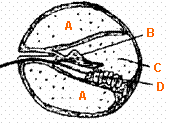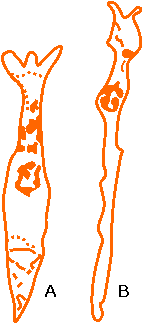Neural Control and Coordination NEET Questions (MCQs) | Neural Control and Coordination Class 11 NEET Questions | Online Test 04
Nervous system in humans: Neural Control and Coordination - MCQs Quiz - 4
Congratulations - you have completed Nervous system in humans: Neural Control and Coordination - MCQs Quiz - 4.
You scored %%SCORE%% out of %%TOTAL%%.
Your performance has been rated as %%RATING%%
Your answers are highlighted below.
Question 1 |
Given below is a diagrammatic cross section of a single loop of human cochlea:
 Which one of the following options correctly represents the names of three different parts?
Which one of the following options correctly represents the names of three different parts?
 Which one of the following options correctly represents the names of three different parts?
Which one of the following options correctly represents the names of three different parts?A: Perilymph, B: Tectorial membrane C: Endolymph | |
B: Tectorial membrane, C: Perilymph, D: Secretory cells | |
C: Endolymph, D : Sensory hair cells, A: Serum | |
D: Sensory hair cells, A: Endolymph B: Tectorial membrane |
Question 2 |
Examine the diagram of the two cell types A and B given below and select the correct option.

Cell-A is the rod cell found evenly all over retina | |
Cell-A is the cone cell more concentrated in the fovea centralis | |
Cell-B is concerned with colour vision in bright light | |
Cell-A is sensitive to low light intensities |
Question 3 |
Which one of the following is the correct difference between Rod Cells and Cone Cells of our retina?
| (1) | Distribution | More concentrated in centre of retina | Evenly distributed all over retina |
| (2) | Visual acuity | High | Low |
| (3) | Visual pigment contained | Iodopsin | Rhodopsin |
| (4) | Overall function | Vision in poor light | Colour vision and detailed vision in bright light |
(1) | |
(2) | |
(3) | |
(4) |
Question 4 |
An action potential in the nerve fibre is produced when positive and negative charges on outside and the inside of the axon membrane are reversed because
all potassium ions leave the axon | |
more potassium ions enter the axon as compared to sodium ions leaving it | |
more sodium ions enter the axon as compared to potassium ions leaving it | |
all sodium ions enter the axon |
Question 5 |
The cutaneous plexus and the papillary plexus consist of
Specialized cells for cutaneous sensations | |
A network of arteries to provide dermal supply | |
A network of nerves to provide dermal sensation | |
Gland cells that release cutaneous secretions |
Question 6 |
Which one of the following pairs of structures distinguishes a nerve cell from other types of cell?
Perikaryon and dendrites | |
Vacuoles and fibres | |
Flagellum and medullary sheath | |
Nucleus and mitochondria |
Question 7 |
Which one of the following is an example of negative feedback loop in humans?
Constriction of skin blood vessels and contraction of skeletal muscles when it is too cold | |
Secretion of tears after falling of sand particles into the eyes | |
Salivation of mouth at the sight of delicious food | |
Secretion of sweat glands and constriction of skin blood vessels when it is too hot |
Question 8 |
During the transmission of nerve impulse through a nerve fibre, the potential on the inner side of the plasma membrane has which type of electric charge?
First positive, then negative and continue to be negative | |
First negative, then positive and again back to negative | |
First positive, then negative and again back to positive | |
First negative, then positive and continue to be positive. |
Question 9 |
Given below is a table comparing the effects of sympathetic and parasympathetic nervous system for four features (a-d). Which one feature is correctly described?
| Feature | Sympathetic Nervous System | Parasympathetic Nervous System |
| (a) Salivary gland | Stimulates secretion | Inhibits secretion |
| (b) Pupil of the eye | Dilates | Constricts |
| (c) Heart rate | Decreases | Increases |
| (d) Intestinal peristalsis | Stimulates | Inhibits |
(a) | |
(b) | |
(c) | |
(d) |
Question 10 |
Patients suffering from cholera are given a saline drip because
NaCl is an important component of energy supply | |
NaCl furnishes most of the fuel required for cellular activity | |
Na+ ions help in stopping nerve impulses and hence, sensation of pain | |
Na+ ions help in the retention of water in the body tissues |
Question 11 |
Unidirectional transmission of a nerve impulse through nerve fibre is due to the fact that:
nerve fibre is insulated by a medullary sheath | |
sodium pump starts operating only at the cyton and then continues into the nerve fibre | |
neurotransmitters are released by dendrites and not by axon endings | |
neurotransmitters are released by the axon endings and not by dendrites |
Question 12 |
Assertion: The imbalance in concentration of Na+, K+ and proteins generates resting potential.
Reason: To maintain the unequal distribution of Na+ and K+, the neurons use electrical energy.
Both Assertion and Reason are true and Reason is the correct explanation of the Assertion. | |
Both Assertion and Reason are true but the Reason is not the correct explanations of Assertion. | |
Assertion is true, but Reason is false. | |
Both Assertion and Reason are false. |
Question 13 |
If vagus nerve in man is damaged, which of the following will not be affected?
pancreatic secretion | |
gastrointestinal movements | |
tongue movements | |
cardiac movements |
Question 14 |
The function of vagus nerve innervating the heart is to
Initiate the heart beat | |
Reduce the heart beat | |
Accelerate the heart beat | |
Maintain constant heart beat |
Question 15 |
Cornea transplant in humans is almost never rejected. This is because:
It is a non-living layer | |
Its cells are least penetrable by bacteria | |
It has no blood supply | |
It is composed of enucleated cells |
Once you are finished, click the button below. Any items you have not completed will be marked incorrect.
There are 15 questions to complete.
Browse this website for remaining chapter wise MCQs on NEET biology | A huge online NEET Biology question bank is available for NEET UG aspirant.



answer of question no 13 is wrong as vagus nerve innervates heart and nerve. tongue is innervated by Hypoglossal nerve.
i m very grateful to u that you are putting this type of question and you are making us ready for entrance …. i thank u once again..
These are very nice questions. Every question has its own importance. It is the perfect field for revision each chapter. thanks